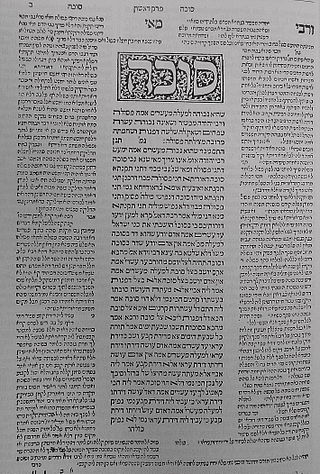Related Research Articles

Ein Yaakov is a 16th-century compilation of all the Aggadic material in the Talmud together with commentaries. Its introduction contains an account of the history of Talmudic censorship and the term Gemara. It was compiled by Jacob ibn Habib and by his son Levi ibn Habib.
Events from the year 1714 in literature.
Biblical poetry such as the Song of the Sea and the Song of Deborah may be considered early examples of Jewish epic poetry, though very short by normal epic standards. Both songs are compared by scholars to Canaanite and Assyrian epic poetry.

Daniel Bomberg was one of the most important early printers of Hebrew books. A Christian Hebraist who employed rabbis, scholars and apostates in his Venice publishing house, Bomberg printed the first Mikraot Gdolot and the first complete Babylonian and Jerusalem Talmuds, based on the layout pioneered by the Soncino family printers, with the commentaries of Rashi, and of the Tosfot in the margins. The editions set standards that are still in use today, in particular the pagination of the Babylonian Talmud. His publishing house printed about 200 Hebrew books, including Siddurim, responsa, codes of law, works of philosophy and ethics and commentaries. He was the first Hebrew printer in Venice and the first non-Jewish printer of Hebrew books.

A maggid, also spelled as magid, is a traditional Jewish religious itinerant preacher, skilled as a narrator of Torah and religious stories. A chaplain of the more scholarly sort is called a darshan. The title of maggid mesharim probably dates from the sixteenth century.

The Dinstagishe un Fraytagishe Kuranten was the earliest known Yiddish-language periodical, founded by Uri Phoebus Halevi. It was a semi-weekly founded in Amsterdam in 1686, that was published on Tuesdays (Dinstag) and Fridays (Fraytag) and it lasted for little over one year. It covered local news and news from other Jewish communities, including those as far away as India. Issues of the paper were discovered in 1902 by the librarian David Montezinos.
Moses ben Abraham or Moshe ben Avraham may refer to:
Hanan of Iskiya (Asikia) (Hebrew: רב חנן מאישקיא/מאישקא; alternative English spellings: Hanan of Iskia, or Hanan of Iskya, or Hanan of Ishqiya) was rector of the Talmudical academy at Pumbedita, 589-608. He was succeeded by Mari ben R. Dimi after his death in 609.
Jewish printers were quick to take advantages of the printing press in publishing the Hebrew Bible. While for synagogue services written scrolls were used, the printing press was very soon called into service to provide copies of the Hebrew Bible for private use. All the editions published before the Complutensian Polyglot were edited by Jews; but afterwards, and because of the increased interest excited in the Bible by the Reformation, the work was taken up by Christian scholars and printers; and the editions published by Jews after this time were largely influenced by these Christian publications. It is not possible in the present article to enumerate all the editions, whole or partial, of the Hebrew text. This account is devoted mainly to the incunabula.
Jacob Tirado was one of the founders of the Spanish-Portuguese community of Amsterdam.
Thomas Jones was a publisher and bookseller in London.
Joseph Abraham Steblicki was a teacher and treasurer who became notable for converting to Judaism.
Avinu means "Our Father" in Hebrew. The term may also refer to:
Immanuel Benveniste was an Italian Jewish printer in Amsterdam who printed many Hebrew works including an edition of the Talmud from 1644-48. He was one of a number of notable Portuguese Jewish printers at Amsterdam in the seventeenth century, including Manasseh ben Israel, David de Castro Tartas, and Joseph and Immanuel Athias. Benveniste also published the sermons of Saul Levi Morteira in 1652.
Abraham ben Jacob was a Dutch Jewish engraver who worked in Amsterdam in the 17th century.
Gershom ben Solomon Kohen was among the first printers of Hebrew books in Prague. He was the founder of the Gersonides, a dynasty of Ashkenazi Jewish printers. Mid-career, he attained rights to be an exclusive printer of Hebrew books in Bohemia authorized to produce Hebrew books.
Abraham ben Moses Schedel was a Bohemian printer and corrector for the press.

The Amsterdam Machzor of 1670 was a heavily ornamented prayer book printed by Uri Phoebus ben Aaron Ha-levi.
Moses Benjamin Wulff (1661–1729) was a Court Jew to Prince Leopold of Anhalt-Dessau, where he dealt in political administration and diplomatic affairs of the German region.
References
- ↑ Heller, Marvin J. (1998). "Moses Ben Abraham Avinu and His Printing-Presses". European Judaism: A Journal for the New Europe. 31 (2): 123–132. ISSN 0014-3006. JSTOR 43740612.
- ↑ Heller, Marvin J. (1999-01-01), "Anhalt (Jessnitz)—Israel Ben Abraham", Printing the Talmud, Brill, pp. 75–83, ISBN 978-90-04-67923-8 , retrieved 2024-09-08
 This article incorporates text from a publication now in the public domain : Singer, Isidore; et al., eds. (1901–1906). The Jewish Encyclopedia . New York: Funk & Wagnalls.
This article incorporates text from a publication now in the public domain : Singer, Isidore; et al., eds. (1901–1906). The Jewish Encyclopedia . New York: Funk & Wagnalls.{{cite encyclopedia}}: Missing or empty|title=(help)